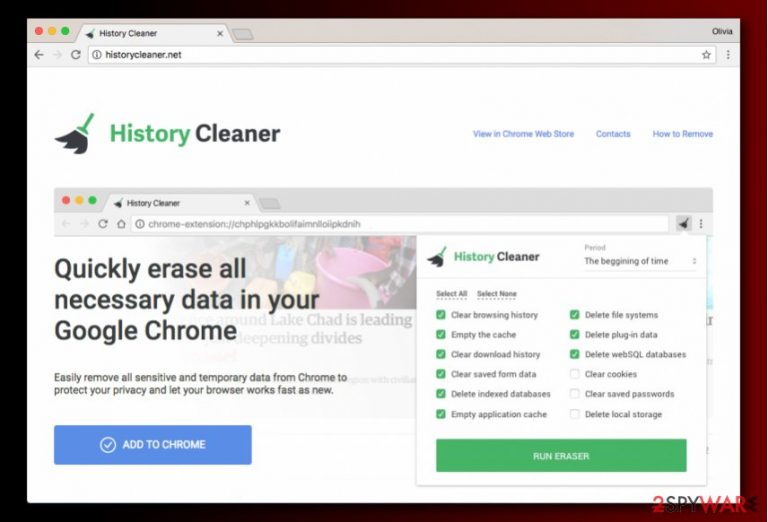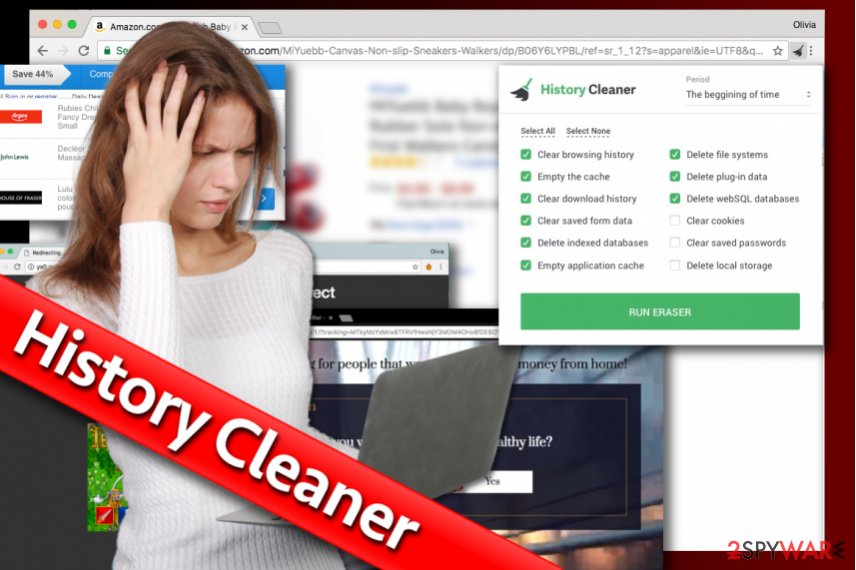History Cleaner virus (Virus Removal Instructions) - Improved Guide
History Cleaner virus Removal Guide
What is History Cleaner virus?
Do not tolerate History Cleaner ads and remove the associated adware for your security

History Cleaner is a highly suspicious Google Chrome extension[1] that presents itself as a tool that helps to erase all necessary data in Google Chrome. However, IT professionals rank it as a potentially unwanted program (PUP) or adware[2], since it hardly does what it promises. Instead of providing promised features only, History Cleaner might display highly annoying web ads during user’s browsing sessions.
History Cleaner virus is a highly suspicious piece of software that should not be kept in the computer system. As soon as it gets a chance to establish itself on victim’s computer, it starts tracking user’s behavior online.
Typically, the adware aims to find out what kind of websites the victim visits or what content he clicks in them. It can also record search queries and collect time stamps showing how much time the victim spent on particular websites. Such activity allows HistoryCleaner developers select proper ads to display for the victim.
The extension communicates with ad networks and then loads commercial offers on the screen in the form of pop-up ads, banners, or even in-text links. It can be hard to understand that these ads do not originate from sites the victim visits.
However, the number of ads the infected computer generates clearly indicates that something is wrong with the system and that it needs a thorough system scan using anti-malware software like FortectIntego.
You can also try to find and remove History Cleaner manually. To delete this highly suspicious threat from Chrome and get rid of its remains for good, we suggest using guidelines prepared by the 2-Spyware team (you can find them below).

Distribution of ad-supported browser extensions
Unwanted browser extensions similar to History Cleaner (for instance, Always Weather, Noter Save and others) sneak into user’s computer alongside vague freeware packages that can be downloaded from the majority of file sharing websites.
It is also possible to encounter a suggestion to install the suspicious program while surfing the Internet if you click on an ad or link leading to the official website of such extension. However, software bundling is a much more efficient technique and therefore it is actively used in History Cleaner’s distribution.
To keep this suspicious extension away from Chrome and your computer system overall, always pick Custom or Advanced settings when installing new software. Installation wizards tend to include permissions to install “recommended” programs in Default or Standard installation options, which, to say at least, look trustworthy at first sight.
However, do not let these deceive you and opt for Custom/Advanced settings instead! Here, deselect all extras without any doubt. Dieviren.de experts report[3] that adware similar to HistoryCleaner has used similar infiltration techniques to infect computers of many German-speaking computer users.
Remove History Cleaner from your browser
Users willing to remove History Cleaner virus from Chrome and other browsers the virus possibly affected should carefully read the instructions provided below the article. We strongly suggest paying close attention to them and following given directions attentively. Do not try to eliminate this adware program hastily.
A complete History Cleaner removal can be completed using anti-spyware or anti-malware programs. If you are out of ideas of what security program to use, consider choosing one of the ones we recommend.
You may remove virus damage with a help of FortectIntego. SpyHunter 5Combo Cleaner and Malwarebytes are recommended to detect potentially unwanted programs and viruses with all their files and registry entries that are related to them.
Getting rid of History Cleaner virus. Follow these steps
Uninstall from Windows
Read the provided guidelines with caution and then follow the provided steps to uninstall History Cleaner adware remains from Windows.
Instructions for Windows 10/8 machines:
- Enter Control Panel into Windows search box and hit Enter or click on the search result.
- Under Programs, select Uninstall a program.

- From the list, find the entry of the suspicious program.
- Right-click on the application and select Uninstall.
- If User Account Control shows up, click Yes.
- Wait till uninstallation process is complete and click OK.

If you are Windows 7/XP user, proceed with the following instructions:
- Click on Windows Start > Control Panel located on the right pane (if you are Windows XP user, click on Add/Remove Programs).
- In Control Panel, select Programs > Uninstall a program.

- Pick the unwanted application by clicking on it once.
- At the top, click Uninstall/Change.
- In the confirmation prompt, pick Yes.
- Click OK once the removal process is finished.
Delete from macOS
Remove items from Applications folder:
- From the menu bar, select Go > Applications.
- In the Applications folder, look for all related entries.
- Click on the app and drag it to Trash (or right-click and pick Move to Trash)

To fully remove an unwanted app, you need to access Application Support, LaunchAgents, and LaunchDaemons folders and delete relevant files:
- Select Go > Go to Folder.
- Enter /Library/Application Support and click Go or press Enter.
- In the Application Support folder, look for any dubious entries and then delete them.
- Now enter /Library/LaunchAgents and /Library/LaunchDaemons folders the same way and terminate all the related .plist files.

Remove from Microsoft Edge
Delete unwanted extensions from MS Edge:
- Select Menu (three horizontal dots at the top-right of the browser window) and pick Extensions.
- From the list, pick the extension and click on the Gear icon.
- Click on Uninstall at the bottom.

Clear cookies and other browser data:
- Click on the Menu (three horizontal dots at the top-right of the browser window) and select Privacy & security.
- Under Clear browsing data, pick Choose what to clear.
- Select everything (apart from passwords, although you might want to include Media licenses as well, if applicable) and click on Clear.

Restore new tab and homepage settings:
- Click the menu icon and choose Settings.
- Then find On startup section.
- Click Disable if you found any suspicious domain.
Reset MS Edge if the above steps did not work:
- Press on Ctrl + Shift + Esc to open Task Manager.
- Click on More details arrow at the bottom of the window.
- Select Details tab.
- Now scroll down and locate every entry with Microsoft Edge name in it. Right-click on each of them and select End Task to stop MS Edge from running.

If this solution failed to help you, you need to use an advanced Edge reset method. Note that you need to backup your data before proceeding.
- Find the following folder on your computer: C:\\Users\\%username%\\AppData\\Local\\Packages\\Microsoft.MicrosoftEdge_8wekyb3d8bbwe.
- Press Ctrl + A on your keyboard to select all folders.
- Right-click on them and pick Delete

- Now right-click on the Start button and pick Windows PowerShell (Admin).
- When the new window opens, copy and paste the following command, and then press Enter:
Get-AppXPackage -AllUsers -Name Microsoft.MicrosoftEdge | Foreach {Add-AppxPackage -DisableDevelopmentMode -Register “$($_.InstallLocation)\\AppXManifest.xml” -Verbose

Instructions for Chromium-based Edge
Delete extensions from MS Edge (Chromium):
- Open Edge and click select Settings > Extensions.
- Delete unwanted extensions by clicking Remove.

Clear cache and site data:
- Click on Menu and go to Settings.
- Select Privacy, search and services.
- Under Clear browsing data, pick Choose what to clear.
- Under Time range, pick All time.
- Select Clear now.

Reset Chromium-based MS Edge:
- Click on Menu and select Settings.
- On the left side, pick Reset settings.
- Select Restore settings to their default values.
- Confirm with Reset.

Remove from Google Chrome
To remove History Cleaner virus from Chrome, open chrome://extensions page and delete the unwanted extension from there. You can also use these guidelines to find and eliminate unwanted extensions from Chrome.
Delete malicious extensions from Google Chrome:
- Open Google Chrome, click on the Menu (three vertical dots at the top-right corner) and select More tools > Extensions.
- In the newly opened window, you will see all the installed extensions. Uninstall all the suspicious plugins that might be related to the unwanted program by clicking Remove.

Clear cache and web data from Chrome:
- Click on Menu and pick Settings.
- Under Privacy and security, select Clear browsing data.
- Select Browsing history, Cookies and other site data, as well as Cached images and files.
- Click Clear data.

Change your homepage:
- Click menu and choose Settings.
- Look for a suspicious site in the On startup section.
- Click on Open a specific or set of pages and click on three dots to find the Remove option.
Reset Google Chrome:
If the previous methods did not help you, reset Google Chrome to eliminate all the unwanted components:
- Click on Menu and select Settings.
- In the Settings, scroll down and click Advanced.
- Scroll down and locate Reset and clean up section.
- Now click Restore settings to their original defaults.
- Confirm with Reset settings.

Delete from Safari
Remove unwanted extensions from Safari:
- Click Safari > Preferences…
- In the new window, pick Extensions.
- Select the unwanted extension and select Uninstall.

Clear cookies and other website data from Safari:
- Click Safari > Clear History…
- From the drop-down menu under Clear, pick all history.
- Confirm with Clear History.

Reset Safari if the above-mentioned steps did not help you:
- Click Safari > Preferences…
- Go to Advanced tab.
- Tick the Show Develop menu in menu bar.
- From the menu bar, click Develop, and then select Empty Caches.

After uninstalling this potentially unwanted program (PUP) and fixing each of your web browsers, we recommend you to scan your PC system with a reputable anti-spyware. This will help you to get rid of History Cleaner registry traces and will also identify related parasites or possible malware infections on your computer. For that you can use our top-rated malware remover: FortectIntego, SpyHunter 5Combo Cleaner or Malwarebytes.
How to prevent from getting adware
Do not let government spy on you
The government has many issues in regards to tracking users' data and spying on citizens, so you should take this into consideration and learn more about shady information gathering practices. Avoid any unwanted government tracking or spying by going totally anonymous on the internet.
You can choose a different location when you go online and access any material you want without particular content restrictions. You can easily enjoy internet connection without any risks of being hacked by using Private Internet Access VPN.
Control the information that can be accessed by government any other unwanted party and surf online without being spied on. Even if you are not involved in illegal activities or trust your selection of services, platforms, be suspicious for your own security and take precautionary measures by using the VPN service.
Backup files for the later use, in case of the malware attack
Computer users can suffer from data losses due to cyber infections or their own faulty doings. Ransomware can encrypt and hold files hostage, while unforeseen power cuts might cause a loss of important documents. If you have proper up-to-date backups, you can easily recover after such an incident and get back to work. It is also equally important to update backups on a regular basis so that the newest information remains intact – you can set this process to be performed automatically.
When you have the previous version of every important document or project you can avoid frustration and breakdowns. It comes in handy when malware strikes out of nowhere. Use Data Recovery Pro for the data restoration process.
